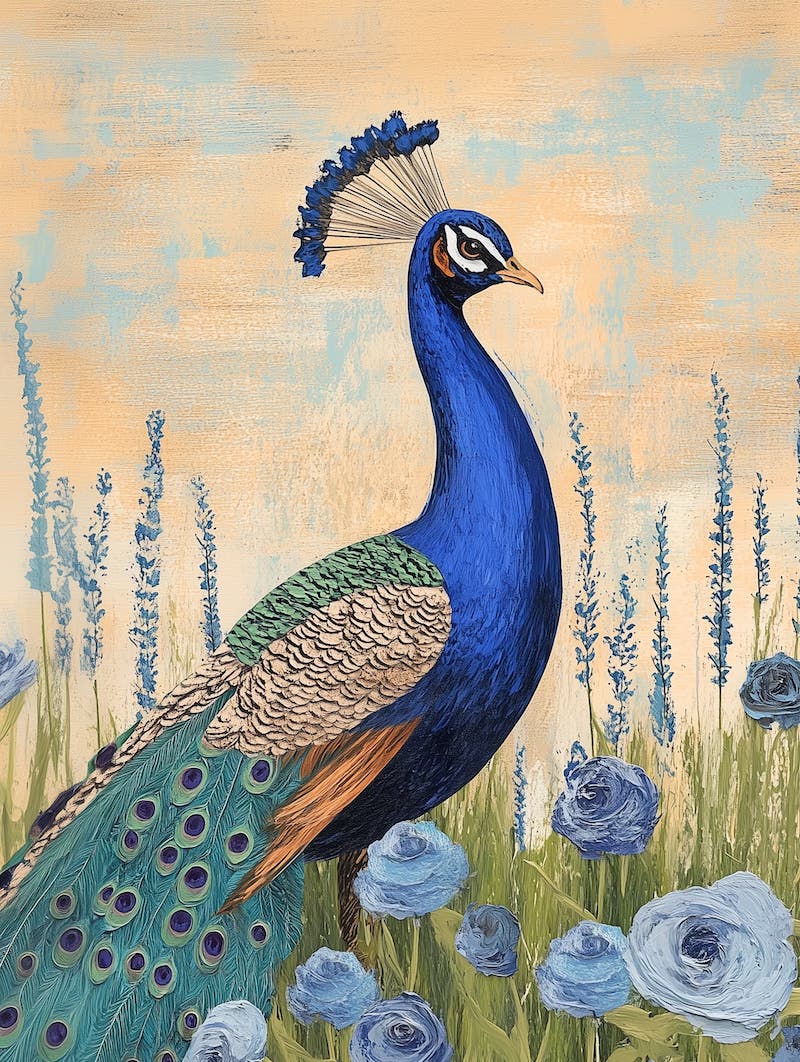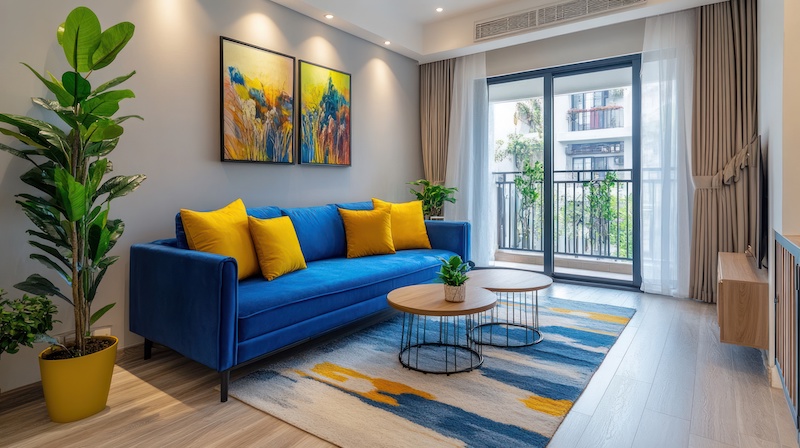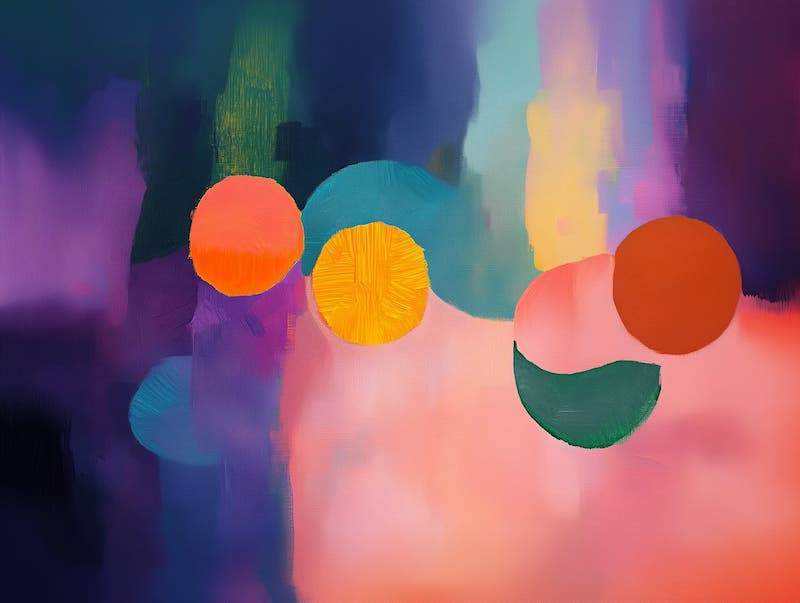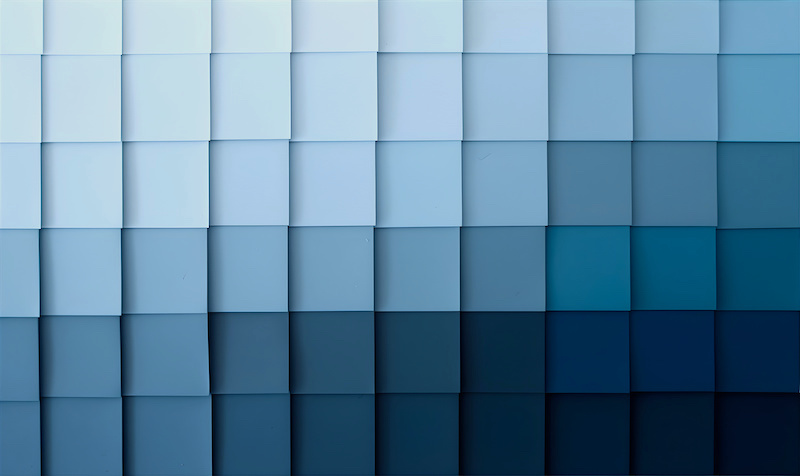What does the color blue represent? Trust. Peace. Calm.
And when you bring the color blue into your home, something special happens. A busy room becomes a quiet space. A stressed mind finds rest.
Want a room where you can relax after a hard day? Light blue walls might be your answer. Need to focus better in your home office? A deep navy blue could help. The color psychology of blue works because it affects how we feel and think.
Let’s explore why blue matters so much in your home and how to use it right.
How Blue Shows Up in Nature and History

Blue is kind of strange in nature. Most colors come from natural dyes and pigments. But blue? It’s often a trick of light.
Both the sky and ocean show us blue’s beauty daily. The sky isn’t really blue. It just looks that way because of how light bounces around air molecules. The ocean reflects the sky. And those beautiful butterflies and birds with blue hues? Their color comes from light hitting tiny structures on their wings and feathers—not actual blue pigment.
For artists long ago, blue paintings were rare because blue was hard to get. They had to crush semiprecious stones into powder. This made blue color rare and expensive.
In ancient Egypt, people treasured lapis lazuli—a deep blue stone. They used it for special jewelry and in royal tombs. In medieval Europe, blue paint sometimes cost more than gold! Artists saved it for important subjects like the Virgin Mary’s robes.
International Klein Blue, a vibrant ultramarine shade, was created in the 1960s and shows how blue still fascinates artists today.
What does the color blue represent in different cultures? Quite a lot:
- In Western culture: trust, calm, and wisdom
- In Eastern cultures: spirituality and immortality
- In China: sometimes used for mourning
- In Hinduism: connected to Krishna
- In the Middle East: protection and safety
How Blue Affects Your Mood

The color psychology of blue does something special to your body and mind. It can:
- Lower your heart rate
- Reduce stress
- Help you focus better
That’s why hospitals, spas, and bedrooms often use serenity blue and other calming blue tones. It works.
Light blues feel open and peaceful. Think of a clear blue sky on a perfect day. That’s the feeling you get.
Dark blues like navy blue bring confidence and depth. They feel solid and trustworthy.
Want to be more productive? Light blue helps with detailed tasks. Need to solve problems? Darker shades of blue are associated with creativity and problem-solving.
Blue hues affect us differently based on their intensity. Soft blues like a robin’s egg create gentle calm. Rich blues like royal blue create more energy while still feeling peaceful.
Blue in Business

Companies know blue’s power. That’s why banks, tech firms, and insurance companies use blue tones in their logos. It makes you trust them.
Facebook. Twitter. LinkedIn. IBM. All blue. Not an accident.
Funny enough, restaurants avoid blue. Why? It can reduce appetite! Blue food is rare in nature, so we’re not programmed to crave it.
In office environments, blue walls can help people work better and feel less stressed. Many interior designers recommend blue for workspaces for this reason. And websites use blue to make you feel safe and stay longer.
How to Decorate With Blue

Adding blue to your living room can completely change how it feels. But where do you start?
Simple Tips for Blue Rooms
Start with neutral shade basics. Too much blue can feel overwhelming. White, grey, or beige walls give you a canvas to work with. Wall paint choices matter—pick a neutral that complements your blue.
Pick the right blue for your goals. Light blue calms. Dark blue adds drama. Teal gives you soothing with a bit of warmth.
Balance cool with warm. Blue can feel cold if that’s all you use. Add touches of orange, yellow, or red to warm things up. The color wheel can guide you—look at colors opposite blue for perfect contrast.
Try blue with other cool colors. Blue works great with greens and purples. Just make sure the undertones match. Pair blue with similar cool tones for a cohesive look.
Start small. Not ready for blue walls? Try blue accents like pillows, throws, or vases first. The 60-30-10 rule helps: use your main color for 60% of the room, a secondary color for 30%, and an accent color for 10%.
Perfect Blue Color Pairs

Light blue pairs with:
- Soft grey: keeps things calm and airy
- Warm beige: adds coziness without losing the peace
- Sage green: creates a fresh, spa-like feel
Dark blue pairs with:
- Burnt orange: adds energy and warmth
- Deep burgundy: makes a rich, grown-up space
- Cool silver: keeps things modern and balanced
Royal blue pairs with:
- Gold: instant luxury and class
- Emerald green: rich and bold without being too much
- Crisp white: lets the blue stand out
Navy blue pairs with:
- Warm taupe: softens the dark blue’s strength
- Rust red: adds earthy warmth
- Blush pink: unexpected but works beautifully
Baby blue pairs with:
- Lavender: soft and dreamy
- Soft yellow: cheerful but still gentle
- Ivory: warm and delicate
Looking at the color wheel helps you find perfect matches. Colors opposite blue (like orange) create energy. Colors next to blue (like green) create harmony.
When you combine blue with warm materials like wood or brass, the combo feels balanced and inviting. Love blue but worried it feels too cold? These pair blue strategies help warm things up.
Blue Living Room Ideas

A blue living room does more than look good. It actually helps you relax and stress less.
Light blue makes rooms feel bigger—perfect for small spaces. Dark blues add depth and make a space feel fancy.
Want an easy upgrade? Try blue living room decor like throw pillows, a rug, or wall art. These small touches make guests feel welcome without overwhelming the space.
Blue works best when balanced with neutral colors. This keeps the living room from feeling too cold or intense.
Adding elements of nature—like blue flowers or seashells—makes the blue feel even more calming. Your living room becomes a true escape from the world.
Blue living room ideas work for any style:
- Modern: Try navy blue with clean lines and metal accents
- Coastal: Light blue with white creates that beach house feel
- Traditional: Royal blue with wood tones feels classic and timeless
- Minimalist: Pale blue walls with simple furniture creates calm
Even if you rent and can’t paint, blue accents transform a living room instantly.
Working With Different Shades of Blue

The magic of blue is how different shades create different feelings in a living room or any space.
Sky blue and pale blue open up small rooms. They’re perfect for bedrooms and bathrooms where you want to relax.
Navy blue and indigo add depth and help you focus. Use these in home offices or places where you need to concentrate.
Try light blue walls with darker blue furniture or accessories. This creates layers that feel balanced and interesting.
Various shades of blue work together beautifully. The trick is balancing blue tones—some lighter, some darker—across your space.
Blue hues are especially good for spaces where you:
- Want to lower blood pressure and anxiety
- Need to focus on detailed work
- Read or meditate
- Connect with family and friends
When planning your home’s color scheme, mix different blues that work together but serve different purposes in each room.
Interior designers often recommend blue because it works with almost any decor style. From modern to farmhouse, there’s a blue that fits.
Make Your Home Better With Blue
Blue brings something special to your home. Its long history and powerful effect on mood make it more than just a pretty color.
Light blues create calm spaces where you can breathe easier. Deep blues build rooms where creativity flows. Either way, blue doesn’t just change how your home looks—it changes how you feel in it.
Whether you paint an entire room or just add blue accents like a throw blanket, this color can turn your house into a place that truly feels like home.




